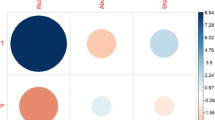Abstract
Oligonychus perseae (Acari: Tetranychidae) is an important foliar spider mite pest of ‘Hass’ avocados in several commercial production areas of the world. In California (USA), O. perseae densities in orchards can exceed more than 100 mites per leaf and this makes enumerative counting prohibitive for field sampling. In this study, partial enumerative mite counts along half a vein on an avocado leaf, an industry recommended practice known as the “half-vein method”, was evaluated for accuracy using four data sets with a combined total of more than 485,913 motile O. perseae counted on 3849 leaves. Sampling simulations indicated that the half-vein method underestimated mite densities in a range of 15–60 %. This problem may adversely affect management of this pest in orchards and potentially compromise the results of field research requiring accurate mite density estimation. To address this limitation, four negative binomial regression models were fit to count data in an attempt to rescue the half-vein method for estimating mite densities. These models were incorporated into sampling plans and evaluated for their ability to estimate mite densities on whole leaves within 30-tree blocks of avocados. Model 3, a revised version of the original half-vein model, showed improvement in providing reliable estimates of O. perseae densities for making assessments of general leaf infestation densities across orchards in southern California. The implications of these results for customizing the revised half-vein method as a potential field sampling tool and for experimental research in avocado production in California are discussed.





Similar content being viewed by others
References
Aanensen DM, Huntley DM, Feil EJ, Al-Own F, Spratt BG (2009) EpiCollect: linking smartphones to web applications for epidemiology, ecology and community data collection. PLoS One 4(1–7):e6968
Akaike H (1974) A new look at the statistical model identification. IEEE Trans Automat Contr 19:716–723
Aponte O, McMurtry JA (1997) Damage on ‘Hass’ avocado leaves, webbing and nesting behaviour of Oligonychus perseae (Acari: Tetranychidae). Exp Appl Acarol 21:265–272
Bender GS (1993) A new mite problem in avocados. Calif Avocado Soc Yearb 77:73–77
Bolker BM, Brooks ME, Clark CJ, Geange SW, Poulsen JR, Stevens MHH, White JSS (2009) Generalized linear mixed models: a practical guide for ecology and evolution. Trends Ecol Evol 24:127–135
Box GEP, Cox DR (1964) An analysis of transformations. J R Stat Soc Series B Stat Methodol 26:211–252
California Avocado Commission (CAC) (2015) About California avocados. www.californiaavocado.com/fun-avocado-facts. Accessed 23 Sep 2015
Cutting JGM (2003) Research note: impact of spring and summer flush type on flowering intensity in ‘Hass’ avocado. NZ avocado growers’ association annual research report, vol 3. pp 42–47
DePalma E, Jeske DR, Lara JR, Hoddle M (2012) Sequential hypothesis testing with spatially correlated presence-absence data. J Econ Entomol 105:1077–1087
Faraway JF (2006) Extending the linear model with R: generalized linear, mixed effects and nonparametric regression models. Chapman & Hall/CRC, Florida
Gbur EE, Stroup WW, McCarter KS, Durham S, Young LJ, Christman M, West M, Kramer M (2012) Analysis of generalized linear mixed models in the agricultural and natural resource sciences. American Society of Agronomy, Soil Science Society of America, Crop Science Society of America, Wisconsin
González-Fernández JJ, de la Peña F, Hormaza JI, Boyero JR, Vela JM, Wong E, Trigo MM, Montserrat M (2009) Alternative food improves the combined effect of an omnivore and a predator on biological pest control. A case study in avocado orchards. Bull Entomol Res 99:433–444
Henderson CF, McBurnie HV (1943) Sampling technique for determining populations of the citrus red mite and its predators. US Dep Agric Circ 671:1–11. https://archive.org/details/samplingtechniqu671hend
Hernández-Suárez E, Torres-Luis E, López-González AA, Perera-González S, Saavedra-Oliva OL (2010) Evaluación de eficacia de acaricidas y sueltas inundativas de Neoseiulus californicus para el control de la araña cristalina Oligonychus perseae en aguacate. Cabildo Insular de Tenerife and Instituto Canario de Investigaciones Agrarias. http://www.agrocabildo.org/publica/Publicaciones/frut_299_ara%C3%B1a_cristalina_aguacate.pdf. Accessed 2 Oct 2015
Hoddle MS, Morse JG (2012) The persea mite invasion into California: history, biology, management, and current status. Calif Avocado Soc Yearb 95:107–113
Hoddle MS, Robinson L, Virzi J (2000) Biological control of Oligonychus perseae (Acari: Tetranychidae) on avocado: III. Evaluating the efficacy of varying release rates and release frequency of Neoseiulus californicus (Acari: Phytoseiidae). Int J Acarol 26:203–214
Humeres EC, Morse JG (2005) Baseline susceptibility of persea mite (Acari: Tetranychidae) to abamectin and milbemectin in avocado groves in southern California. Exp Appl Acarol 36:51–59
Kaufman KW (1981) Fitting and using growth curves. Oecologia 49:293–299
Kennedy R, McLeman R, Sawada M, Smigielski J (2013) Use of smartphone technology for small-scale silviculture: a test of low-cost technology in Eastern Ontario. Small Scale For. doi:10.1007/s11842-013-9243-5
Kerguelen V, Hoddle MS (2000) Comparison of the susceptibility of several cultivars of avocado to the persea mite, Oligonychus perseae (Acari: Tetranychidae). Sci Hortic 84:101–114
Lara JR, Hoddle MS (2015a) Past, present and future: biological control of spider mites on California-grown avocados. In: Carrillo D, de Moraes GJ, Peña JE (eds) Prospects for biological control of plant feeding mites and other harmful organisms. Springer, New York, pp 271–308
Lara JR, Hoddle MS (2015b) Comparison and field validation of binomial sampling plans for Oligonychus perseae (Acari: Tetranychidae) on Hass avocado in southern California. J Econ Entomol 108:2074–2089
Li JX, Jeske DR, Lara JR, Hoddle M (2012) Sequential hypothesis testing with spatially correlated count data. Integr Math Theory Appl 2:269–284
Machlitt M (1998) Persea mite on avocados: quick field counting method. Subtrop Fruit 6:1–4
Maoz Y, Gal S, Argov Y, Coll M, Palevsky E (2011) Biocontrol of persea mite, Oligonychus perseae, with an exotic spider mite predator and an indigenous pollen feeder. Biol Control 59:147–157
McDonald JH (2009) Handbook of biological statistics: spearman rank correlation, University of Delaware. http://www.biostathandbook.com/spearman.html. Accessed 25 Sep 2015
Morgan CVG, Chant DA, Anderson NH, Ayre GL (1955) Methods for estimating orchard mite populations, especially with the mite brushing machine. Can Entomol 87:189–200
Morse J (2008) Management and resistance monitoring of avocado thrips and persea mite. Production research report, California avocado commission, pp 1–7
Morse J (2011) Management and resistance monitoring of avocado thrips and persea mite. Production research report, California avocado commission, pp 1–3
Olson DD, Bissonette JA, Cramer PC, Green AD, Davis ST, Jackson PJ, Coster DC (2014) Monitoring wildlife-vehicle collisions in the information age: how smartphones can improve data collection. PLoS One 9(1–9):e98613
Pérez-Fernández JJ, Perera-González S, Torres-Luis E, Hernández-Suárez E (2015) Efecto de la aplicación de productos naturales en el control de la arana cristalina (Oligonychus perseae) y sus enemigos naturales. Agrocabildo, Cabildo de Tenerife. http://agrocabildo.org/publica/Publicaciones/agec_575_Aplica_prod_natur_ara%C3%B1a_cristalina.pdf. Accessed 2 Oct 2015
Ratkowsky DA (1990) Handbook of nonlinear regression models. Marcel Dekker Inc, New York
SAS Institute (2011) SAS/STAT 9.3 user’s guide. SAS Institute, North Carolina
Schwarz G (1978) Estimating the dimension of a model. Ann Stat 6:461–464
Sircom J (2000) Photographic sampling: a photographic sampling method for mites on plants. Exp Appl Acarol 24:55–61
Stroup WW (2013) Generalized linear mixed models: modern concepts, methods and applications. CRC Press, Florida
University of California Integrated Pest Management (UC IPM) (2008) Integrated pest management for avocados, publication 3503. University of California, Agriculture and Natural Resources, California
UC IPM (2011) Avocado, monitoring persea and sixspotted mites. University of California, Agriculture and Natural Resources. http://www.ipm.ucdavis.edu/PMG/r8900811.html. Accessed 25 Sept 2015
Yee WL, Phillips PA, Rodgers JL, Faber BA (2001) Phenology of arthropod pests and associated natural predators on avocado leaves, fruit, and in leaf litter in southern California. Environ Entomol 30:892–898
Zahn DK (2011) Aspects of the biology and the effects of traditional and non-traditional insecticides on citrus thrips and avocado thrips with the objective of improving integrated pest management. Ph.D. Dissertation, Dept. of Entomology, University of California
Zappalà L, Kreiter S, Russo A, Tropea Garzia G, Auger P (2015) First record of the persea mite Oligonychus perseae (Acari: Tetranychidae) in Italy with a review of the literature. Int J Acarol 41:97–99
Acknowledgments
This work was supported in part by a USDA-NIFA Regional Integrated Pest Management Competitive Program Grant (2010-34103-21202), the University of California Hansen Trust, and the California Avocado Commission. Financial support to J. Lara was provided, in part, by the Robert Van den Bosch Scholarship. We are indebted to Ruth Amrich, Allison Bistline-East, Mike Lewis, John Jones, and Nick Salvato for field and laboratory assistance. We thank Vincent D’Amico for preparing the sampling cartoon used in Fig. 1. Numerous growers provided unlimited access to their avocado orchards for which we are grateful.
Author information
Authors and Affiliations
Corresponding author
Rights and permissions
About this article
Cite this article
Lara, J.R., Saremi, N.T., Castillo, M.J. et al. Sampling method evaluation and empirical model fitting for count data to estimate densities of Oligonychus perseae (Acari: Tetranychidae) on ‘Hass’ avocado leaves in southern California. Exp Appl Acarol 68, 455–475 (2016). https://doi.org/10.1007/s10493-016-0018-5
Received:
Accepted:
Published:
Issue Date:
DOI: https://doi.org/10.1007/s10493-016-0018-5




